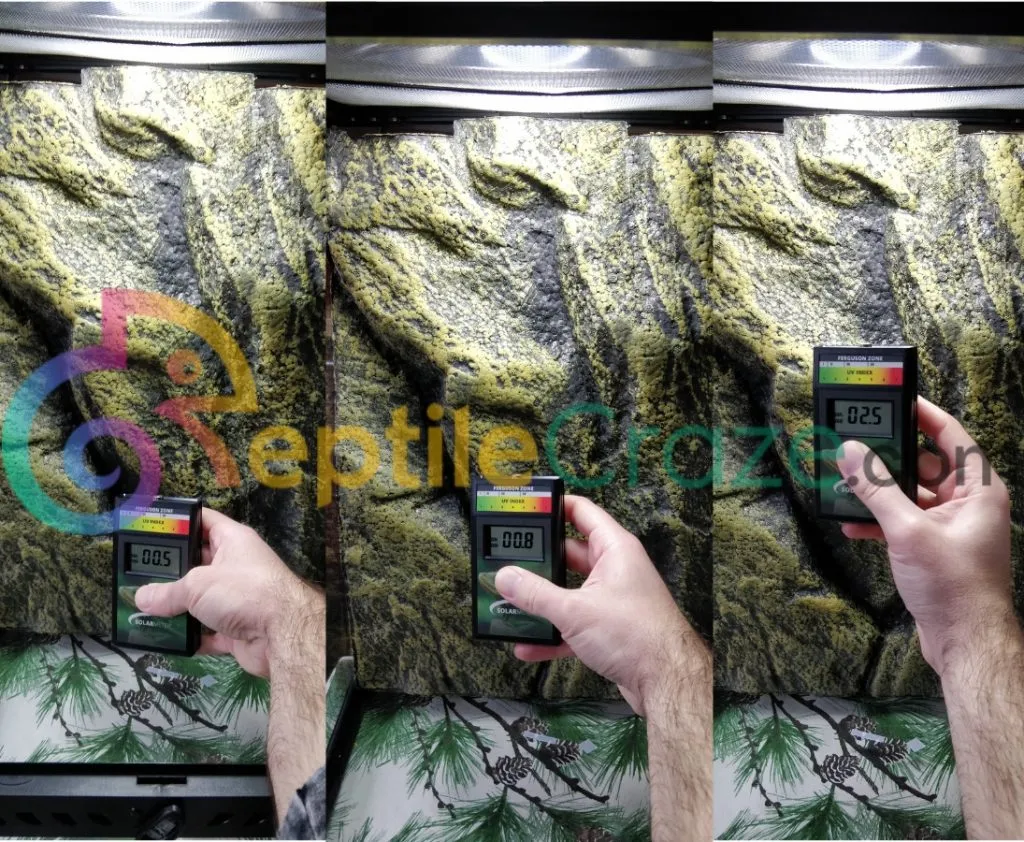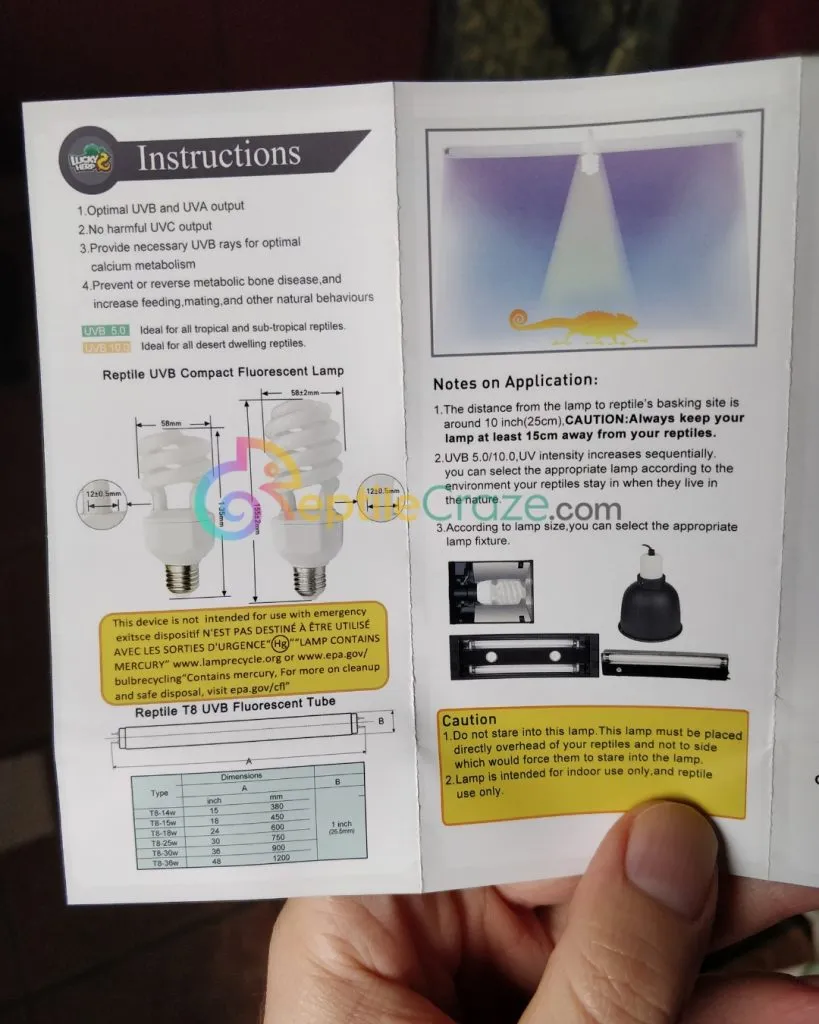
The Lucky Herp UVB 10.0 Compact Fluorescent Lamp is said to be great for the UVB lighting needs of desert-dwelling reptiles. Is its UVB output strong enough? Does it live up to its claims? Can other reptiles benefit from this lamp?
In this review, we are going to take a closer look at how well the Lucky Herp UVB 10.0 performs based on its UV output claims. We will also discuss why this lamp is not the best option for desert-dwelling reptiles. So read on!
Table of Contents
Do We Recommend The Lucky Herp UVB 10.0 Compact Fluorescent Lamp?
All in all, the Lucky Herp UVB 10.0 is still a good bulb to use, but its UV output is not that great compared to other bulbs in the market.
We do not recommend this to be used on desert-dwelling reptiles due to the low UVB output. Instead, this can be of use to reptiles that are within the Ferguson Zone 2.
Some of the reptiles that belong to the Ferguson Zone 2 are boa constrictors, western hognose snakes, common musk turtles, emerald tree monitors, green anoles, blue tongue skinks, etc.
If you are looking for a lamp for desert-dwelling reptiles, it is better to go for the Zoo Med Reptisun 10.0 for its high UV output. You can check out our review here.
Features Of The Lucky Herp UVB 10.0
We purchased the Lucky Herp UVB 10.0, and it arrived safe and secure. It has compact packaging and the bulb itself is protected by foam.

As you can see, the bulb is quite big so it needs a bigger lamp fixture. Other users of this bulb found that the Repti Zoo Reptile Dome Dual Lamp Fixture works well. At the same time, it has an extra slot for a bulb that can be used for heating.
This bulb is only used for UVB lighting, so you need a separate bulb to heat the enclosure.

Upon testing the bulb, we noticed that it also emits heat. So we measured the temperature to see how hot it gets and if it is possible to heat the enclosure.
The left image shows the temperature when it is initially switched on. The one on the right is the temperature of about 20 minutes after leaving it on.
So there is some heat output, but still, it is not sufficient heating for desert-dwelling reptiles.

We measured the UV Index at different distances to check the UV output. We used the SolarMeter 6.5R to measure the output. The distances from left to right are as follows:
- 30 cm. or 11.8 in.
- 25 cm. or 9.8 in.
- 15 cm. or 5.9 in.
Keep in mind that this bulb is specifically marketed for desert-dwelling reptiles like frilled dragons, bearded dragons, and savannah monitors. As you can see from the results, the outputs are too low.
Take for example a bearded dragon that is a Ferguson Zone 3 reptile that has a UVI of 3.0-7.0. It cannot benefit from the output if it is 30 cm. or 25 cm. away.
It is only when it gets really close to the bulb which is about 15 cm. that the output merely reaches 2.5 UVI, which again is not enough as it should be 3.0.

In an effort to make this bulb reach its output claims, we also removed the screen cover since manufacturers claim that the mesh can block the UV rays.
The images above are the measurements without the mesh and the results are a bit higher.
Even if there was an increase in the output, we can conclude that these measurements are still not enough for desert-dwelling reptiles, specifically Ferguson Zone 3 reptiles.
Here are the different Ferguson Zones for reference:
- Ferguson Zone 1
- Shade Dweller or Crepuscular Reptiles
- Maximum UVI: 0.6 – 1.4 in the basking zone
- Zone range UVI 0 – 0.7
- Ferguson Zone 2
- Occasional Basker or Partial Sun Reptiles
- Maximum UVI: 1.1 – 3.0 in the basking zone
- Zone range UVI 0.7 – 1.0
- Ferguson Zone 3
- Partial Sun or Open Basker Reptiles
- Maximum UVI: 2.9 – 7.4 in the basking zone
- Zone range UVI 1.0 – 2.6
- Ferguson Zone 4
- Mid-Day Sun Basker Reptiles
- Maximum UVI: 4.5 – 9.5 in the basking zone
- Zone range UVI 2.6 – 3.5
| Ferguson Zone | Reptiles In That Zone |
| Ferguson Zone 1 | leopard geckos, crested geckos, tokay geckos, royal pythons, Burmese pythons, milk snakes, green tree pythons, reticulated pythons, Fiji banded iguanas, carpet pythons corn snakes |
| Ferguson Zone 2 | emerald tree monitors, Australian water dragons, green anoles, pygmy chameleons, monkey-tailed skinks, red foot tortoises, ornate box turtles, garter snakes, boa constrictors, western hognose snakes, red-tailed rat snakes, blue-tongued skink, Chinese water dragon, common musk turtle, panther chameleon |
| Ferguson Zone 3 | frilled lizard, black and white tegu, Standing’s day gecko, Indian star tortoise, Yemen chameleon, leopard tortoise, diamond python, spotted turtle, bearded dragon, green iguana, bosc monitor, painted turtle, African spur-thighed tortoise, red-eared slider |
| Ferguson Zone 4 | uromastyx, chuckwalla, Texas horned lizard, rhinoceros iguana |

As noted with the instructions that came with the bulb, the reptile should be at least 15 cm. away from the lamp.
Keep in mind, that this bulb is supposed to be used on desert-dwelling reptiles, so if they need to be at least close to 15 cm. to get the barely 3.0 output, the claims of this bulb are inaccurate.
Does The Lucky Herp UVB 10.0 Have A Warranty?

It does have a warranty. However, it is only up to 3 months. When compared to other bulbs, like the Zoo Med Powersun, the warranty is usually 6 months.
The default warranty of 6 months to a year of bulbs that also emit UVB is actually due to the fact that the UVB output of these bulbs naturally decreases through regular use.
The maximum number of months that a bulb can produce a consistent UVB output is 6 months.
This presses the question as to why this bulb only has a warranty of 3 months.
We can only guess that this is the given period as the output is already in the lower ranges based on our tests and that it will decrease even more with regular use, by the third month the bulb may no longer be of use.
Does The Lucky Herp UVB 10.0 Burn Out Quickly?
So far, the bulb that we have is working fine and we did not experience fluctuations. However, it is good to note that there are also other users that experienced quick burn out with this bulb.
Many of these users have experienced this bulb burning out in just three weeks. Some also experienced it burning out in one to two months.
The warranty comes in handy in this situation as you can have it replaced, but still, this can be quite a hassle.
Conclusion
The Lucky Herp UVB 10.0 is not ideal for desert-dwelling reptiles or reptiles that belong to Ferguson Zone 3. Even if it is advertised as such, its actual UVB output has a huge discrepancy compared to its output claims.
It is better to be used on reptiles that are in the Ferguson Zone 2. Further, this bulb is not meant to be a heat source, so you need a separate light for that.
- Enchi Ball Python: A Unique and Stunning Morph of Python regius - March 27, 2025
- Emerald Tree Monitor: The Enigmatic Green Guardian of the Rainforest - March 26, 2025
- The Egyptian Cobra (Naja haje): A Fascinating Serpent - March 25, 2025

